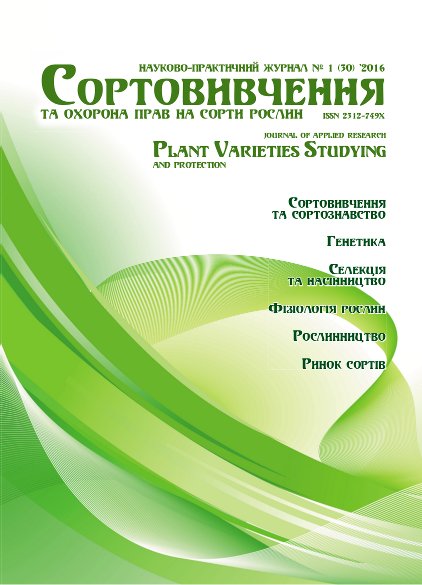Fusarium head blight of winter triticale varieties in the Forest-Steppe zone of Ukraine
DOI:
https://doi.org/10.21498/2518-1017.1(30).2016.61782Keywords:
winter triticale, variety samples, Fusarium, disease developmentAbstract
Purpose. Studying variety samples of winter triticale of various ecological and geographical origin for revealing polymorphism of the culture for its susceptibility to pathogenic complex of Fusarium head blight and defining high-yielding and resistant to diseases varieties that later can be put into the production and breeding process. Methods. Field experiments, statistical evaluation. Results. It was defined that the development of Fusarium head blight in different variety samples of winter triticale depends on the hydrothermal conditions and genotype of the host-plant. Resistance of varieties and hybrids to the disease was partial, and no immune samples were found among the analyzed ones. The following varieties proved to be tolerant to Fusarium head blight: ‘Granat’, ‘Zorro’, ‘Obrii Myronivskyi’. The positive correlation between the development of Fusarium head blight and root rot of winter triticale was found. It was determined that in the pathogenic complex of Fusarium head blight the amount of the following pathogens is increasing: Fusarium sporotrichioides, F. аvenaceum and F. poae. Conclusions. The leading varieties that combine high yields and resistance to Fusarium head blight are as follows: ‘Obrii Myronivskyi’, ‘ADM 8’, ‘Yuvileine Volynske’, ‘Yukon’, ‘Zorro’, ‘Tsekad 90’, ‘Zerniatko’, ‘Legion’ and ‘Rarytet’. These varieties should be involved in the selection process to breed the hybrids with the augmented resistance to the disease and high yields.
Downloads
References
Arsenyuk, E., & Chembor, Kh. E. (1990). Naibolee rasprostranennye bolezni tritikale, rzhi i pshenitsy v Polshe [The most common diseases of triticale, rye and wheat in Poland]. Tritikale v Vostochnoy Evrope [Triticale in Eastern Europe], (pp. 117–132). Gorzów Wielkopolski: Małyszyn [in Russian].
Prygge, G., Herkhard, M., Khabermaier, I. (2004). Gribnye bolezni zernovykh kultur [Fungal diseases of crops]. Yu. M. Stroykov (Ed.). Münster: Landwirtschaftsverlag GmbH [in Russian].
Gulbis, K., Javoisha, B., & Treikale, O. (2014). Seed infection of cereals and efficacy of fungicides for seed treatment in Latvia. Abstract of the 11th Conference of the European Foundation for Plant Pathology “Healthy plants – healthy people”. Kraków, 8–13 Sept., 2014. (р. 279.). Kraków, Poland.
Nielsen, L. K., Justesen, A. F., Jensen, J. D., & Jørgensen, L. N. (2013). Microdochium nivale and Microdochium majus in seed samples of Danish small grain cereals. Crop Protection, 43, 192–200.
Retman, S. V., & Kyslykh, T. M. (2011). Fuzarioz kolosa. Analiz zmin u fitopatohennomu kompleksi [Fusarium ear blight. Analysis of changes in phytopathogenic complex]. Karantin i zahist roslin [Quarantine and Plant Protection], 2, 1–3 [in Ukrainian].
Karadzheva, L. V. (1989). Fuzariozy polevykh kultur [Fusarium diseases of field crops]. Kishinev: Shtiintsa [in Russian].
Gagkaeva, T. Yu., Gavrilova, O. P., Levitin, M. M., & Novozhilov, K. V. (2011). Fuzarioz zernovykh kul’tur [Fusarium diseases of field crops]. Zashchita i karantin rastenii [Plant Protection and Quarantine], 5, 91–92 [in Russian].
Kovalyshyna, H. M., Murashko, L. A. (2010). Furarioz kolosa na ozymii pshenytsi [Fusarium head blight of winter wheat]. Naukovo-tekhnichnui biuleten Myronivskoho instytutu pshenytsi imeni V. M. Remesla [Scientific and technical bulletin of the V. M. Remeslo Myronivka Institute of Wheat], 10, 138–144 [in Ukrainian].
Snijders, C. H. A. (1990). Systemic fungal growth of Fusarium culmorum in stems of winter wheat. Journal of Phytopathology, 129(2), 133–140.
Snijders, C. H. A. (1990). Genetic variation for resistance to Fusarium head blight in bread wheat. Euphytica, 50, 171–179.
Mesterházy, Á., Bartók, T., Kászonyi, G., Varga, M., Tóth, B., & Varga, J. (2005). Common resistance to different Fusarium spp. causing Fusarium head blight in wheat. European J. Plant Path., 112(3), 267–281.
Miedaner, T. (1997). Breeding wheat and rye for resistance to Fusarium diseases. Plant Breeding., 116(3), 201–220.
Dospekhov, B. A. (1985). Metodika polevogo opyta (s osnovami statisticheskoy obrabotki rezul’tatov issledovaniy) [Methods of field experiment (with the basics of statistical evaluations of research results)]. (5th ed., rev.). Moscow: Agropromizdat [in Russian].
Retman, S.V. (2001). Khvoroby zernovykh kolosovych kultur [Diseases of spiked cereals]. In S. O. Trybel (Ed.), Metodyky vyprobuvannia i zastosuvannia pestytsydiv [Methods of testing and applying pesticides] (pp. 267–270), Kyiv: Svit [in Ukrainian].
Trybel, S. O., Hetman, M. V., Stryhun, O. O., Kovalyshyna, H. M., & Andriushchenko, A. V. (2010). Metodolohiia otsiniuvannia stiikosti sortiv pshenytsi proty shkidnykiv i zbudnykiv khvorob [Methodology of estimation of wheat varieties resistance to pests and pathogens of diseases]. (S. O. Trybel, Ed.). Kyiv: Kolobih [in Ukrainian].
Phenological growth stages and BBCH-identification keys of cereals (1997). In Meier, U. (Ed.) Growth stages of Mono- and Dicotyledonous Plants. BBCH-Monograph. (pp. 12–16). Berlin; Wien: Blackwell Wissenschafts-Verlag.
Downloads
Published
How to Cite
Issue
Section
License
Copyright (c) 2016 Ukrainian Institute for Plant Variety Examination

This work is licensed under a Creative Commons Attribution-ShareAlike 4.0 International License.
Starting in 2022, the copyright to the publication remains with the authors
Our journal abides by the CREATIVE COMMONS copyright rights and permissions for open access journals.
Authors, who are published in this journal, agree to the following conditions:
- The authors reserve the right to authorship of the work and pass the first publication right of this work to the journal under the terms of a Creative Commons Attribution License, which allows others to freely distribute the published research with the obligatory reference to the authors of the original work and the first publication of the work in this journal.
- The authors have the right to conclude separate supplement agreements that relate to non-exclusive work distribution in the form in which it has been published by the journal (for example, to upload the work to the online storage of the journal or publish it as part of a monograph), provided that the reference to the first publication of the work in this journal is included.

























 Ukrainian Institute for Plant Varieties Examination
Ukrainian Institute for Plant Varieties Examination  Селекційно-генетичний інститут
Селекційно-генетичний інститут Institute of Plant Physiology and Genetics of the National Academy of Sciences of Ukraine
Institute of Plant Physiology and Genetics of the National Academy of Sciences of Ukraine
 The National Academy of Agrarian Sciences of Ukraine
The National Academy of Agrarian Sciences of Ukraine